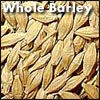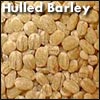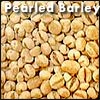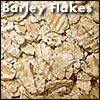All About Barley

Much like rye, barley can grow in harsh conditions and poor soils where other grains wouldn't produce well. Being an ancient grain, barley was one of the first grains domesticated, even before wheat was cultivated. Not used as much as it once was as a food, barley is still a very important crop in today's market place. Today, barley is primarily used as animal feed and for making malt in the making of beer. However, on a smaller scale, barley can be processed for human consumption in the form of pot or hulled barley, pearled barley and barley flakes. Barley's nutrition is much like wheat's. There are a few minor differences, however. Barley contains twice as many fatty acids as wheat which accounts for it's 10% higher calorie count. And as great as wheat's fiber content is, barley contains about 40% more, or over 17%. Barley contains vitamin E; wheat contains none. And barley contains 68% more thiamin, 250% more riboflavin and 38% more lysine than wheat, giving barley a more balanced protein.
Barley's nutrition is much like wheat's. There are a few minor differences, however. Barley contains twice as many fatty acids as wheat which accounts for it's 10% higher calorie count. And as great as wheat's fiber content is, barley contains about 40% more, or over 17%. Barley contains vitamin E; wheat contains none. And barley contains 68% more thiamin, 250% more riboflavin and 38% more lysine than wheat, giving barley a more balanced protein.
Whole barley must be prepared for human consumption because of it's hard, fibrous hull that is not easily removed. Only buy barley in it's whole form if you want to sprout it and eat it as barley grass. Processors use an abrasive machine to remove the hull making it safe to eat. At this stage it's called hulled or pot barley. In this processed form, the germ has been damaged to the point that it will no longer sprout. Pearled barley, which is hulled barley with the ends of the kernel removed so it's round in shape is another popular way you can get barley. Pearled barley has it's germ and much of the bran around the endosperm removed. This is where many of the vitamins and minerals are found and because of this, it's nutritional qualities are down about 25%-33% from what you generally find in hulled barley. But pearled barley cooks up much quicker which is it's big advantage. Both pearled barley and hulled barley are primarily used in soups and stews where they fluff up to almost the size of a pea. Some people also cook a pot of hulled or pearled barley and eat it as a breakfast cereal. It's also sometimes an ingredient in vegetable stuffing or used in pilafs. You can make barley flour at home by putting hulled or pearled barley though your grain grinder. Barley flour has a weaker gluten than wheat flour so when making yeast breads, you will not want to add more than 50% barley flour to your wheat flour. In some parts of the world such as Scotland and Ireland, barley flour plays a predominant part in their baking. Barley flour adds a nutty and appealing flavor to your baked goods. When making pancakes, biscuits and rolls, you can use 100% barley flour and still get good results.
You can make barley flour at home by putting hulled or pearled barley though your grain grinder. Barley flour has a weaker gluten than wheat flour so when making yeast breads, you will not want to add more than 50% barley flour to your wheat flour. In some parts of the world such as Scotland and Ireland, barley flour plays a predominant part in their baking. Barley flour adds a nutty and appealing flavor to your baked goods. When making pancakes, biscuits and rolls, you can use 100% barley flour and still get good results. Barley 'flakes' are made by rolling hulled barley. It looks almost identical to rolled oats and can be used like rolled oats in making cooked breakfast cereal. Barley flakes are also a perfect ingredient for granola. A few barley flakes mixed with bread dough gives your breads a unique texture and makes them even more healthy with a robust appearance and an enhanced flavor.
Barley 'flakes' are made by rolling hulled barley. It looks almost identical to rolled oats and can be used like rolled oats in making cooked breakfast cereal. Barley flakes are also a perfect ingredient for granola. A few barley flakes mixed with bread dough gives your breads a unique texture and makes them even more healthy with a robust appearance and an enhanced flavor.
For the qualities barley possesses it is far under-used in North America today. Inexpensive in price, barley in it's many forms can be used to add wholesome, nutritional goodness to the vast majority of foods you cook every day.
Barley Recipes
http://starburst.cbl.cees.edu/~tara/mushbarley.html Mushroom Barley Soup
References:
The Prudent Pantry by Alan T. Hagen
http://www.godsbanquet.com/recipes/grain.htm